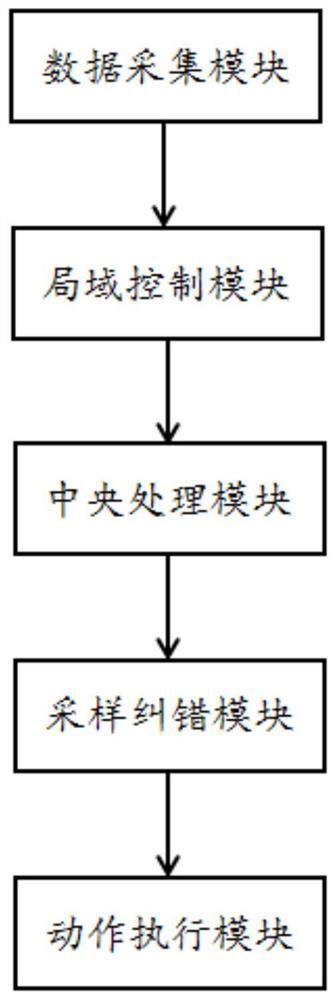Intelligent building control method and system based on Internet of Things sensing
A technology of IoT sensing and control systems, applied in general control systems, control/adjustment systems, program control, etc., can solve problems such as complex control processes, achieve the effects of reducing complexity, facilitating implementation, and improving real-time performance
- Summary
- Abstract
- Description
- Claims
- Application Information
AI Technical Summary
Problems solved by technology
Method used
Image
Examples
Embodiment 1
[0042] The embodiment is basically as attached figure 1 shown, including:
[0043] The data collection module is used to collect raw data of a type corresponding to its own type, and send the raw data;
[0044] The local control module is used to receive the original data, analyze the original data, obtain and upload the analysis result and abnormal notification; and generate the first control instruction according to the analysis result, and send the first control instruction to the action execution module;
[0045] The central processing module is used to send an upload request of the analysis result to the local area control module, receive the analysis result uploaded by the local area control module; and judge whether there is an abnormality in the analysis result, and if there is an abnormality in the analysis result, receive the abnormality uploaded by the local area control module Notify, generate and send sampling detection instructions to the sampling error correcti...
Embodiment 2
[0055] The only difference from Embodiment 1 is that in S5, the action execution module receives the first control instruction and the second control instruction, and executes the corresponding action offline based on the preset general control model according to the first control instruction and the second control instruction , if there is a situation that cannot be controlled offline based on the general control model, the action execution module will send the situation that cannot be controlled offline based on the general control model to the central processing module, and the central processing module will receive the situation that cannot be controlled offline based on the general control model, forming a new general The control model can be implemented with reference to the comparative technology here, and will not be repeated here. In this way, multiple buildings can be controlled offline at the same time, thereby improving the control efficiency of smart buildings; if ...
Embodiment 3
[0057] The only difference from Embodiment 2 is to identify whether there is a major source of danger in the building; the specific process is as follows:
[0058] First, obtain the status information of the hazard source. The status information includes the characteristic parameters of the hazard source itself and the environmental parameters of the hazard source. For example, the characteristic parameters include the type, quantity, volume, physical state and material properties of the hazard source, and the environmental parameters Including temperature, light;
[0059] Then, the accident type corresponding to the hazard source and the occurrence probability of each type of accident are predicted through the pre-built accident evolution model. For example, the state information of the hazard source is used as the input of the accident evolution model, and the accident type and the occurrence probability of each type of accident As the output of the accident evolution model,...
PUM
 Login to View More
Login to View More Abstract
Description
Claims
Application Information
 Login to View More
Login to View More - R&D
- Intellectual Property
- Life Sciences
- Materials
- Tech Scout
- Unparalleled Data Quality
- Higher Quality Content
- 60% Fewer Hallucinations
Browse by: Latest US Patents, China's latest patents, Technical Efficacy Thesaurus, Application Domain, Technology Topic, Popular Technical Reports.
© 2025 PatSnap. All rights reserved.Legal|Privacy policy|Modern Slavery Act Transparency Statement|Sitemap|About US| Contact US: help@patsnap.com

